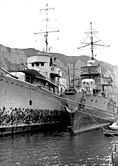User:Alxt
Hey Hey! Perfect homepage for me, feel free to help make it better...
All The Useful Stuff I Need
Open TasksYou can help improve the articles listed below! This list updates frequently, so check back here for more tasks to try. (See Wikipedia:Maintenance or the Task Center for further information.) Fix spelling and grammar
Fix wikilinks
Update with new information
Expand short articles
Check and add references
Fix original research issues
Improve lead sections
Add an image
Help counter systemic bias by creating new articles on important women. Help improve popular pages, especially those of low quality.
Featured Article of the DayLjubljana was the third and last Beograd-class destroyer built for the Royal Yugoslav Navy in the late 1930s. She was designed to operate as part of a division led by Dubrovnik, the flotilla leader. Ljubljana entered service in November 1939, was armed with a main battery of four Škoda 120 mm (4.7 in) guns in single mounts, and had a top speed of 35 knots (65 km/h; 40 mph). In 1940, Ljubljana ran aground on a reef off the Yugoslav port of Šibenik, where, badly damaged, she was taken for repairs. Yugoslavia entered World War II when the Axis powers led by Germany invaded in April 1941, and Ljubljana—still under repair—was captured by the Royal Italian Navy. After repairs were completed, she saw active service in the Royal Italian Navy under the name Lubiana, mainly as a convoy escort on routes between Italy and North Africa. She was lost on 1 April 1943, when she ran aground and was abandoned off the Tunisian coast. (This article is part of a featured topic: Ships of the Royal Yugoslav Navy.) Picture of the DayCecilia Payne-Gaposchkin (1900–1979) was a British-born American astronomer and astrophysicist who proposed in her 1925 doctoral thesis that stars were composed primarily of hydrogen and helium. Her groundbreaking conclusion was initially rejected because it contradicted the scientific wisdom of the time, which held that there were no significant elemental differences between the Sun and Earth. Independent observations eventually proved she was correct. Her work on the nature of variable stars was foundational to modern astrophysics.Photograph credit: Science Service; restored by Adam Cuerden
|
Articles I Have Written
Articles I Have Improved
Wikipedia Useful Stuff
|
Inspired by fine work from User:Siroxo


